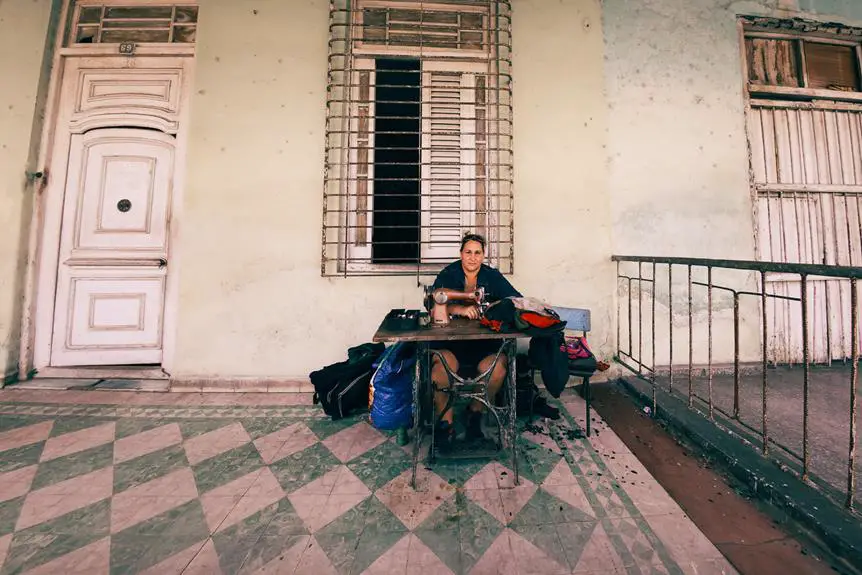You're ready to conquer the challenge of sewing stretchy fabrics with finesse. Mastering the art of working with these materials requires precise techniques and a keen eye for detail.
By implementing five key tips, you can elevate your sewing game and achieve flawless results.
From selecting the right needle and thread to mastering the art of handling and cutting stretchy fabrics, each tip is essential for success.
With the correct stitch type, seam management, and tension adjustments, you'll be well on your way to perfecting your sewing skills with stretchy fabrics.
These tips will empower you to confidently tackle projects that demand expertise in sewing with stretchy materials.
Key Takeaways
- Use a ballpoint needle designed for knit fabrics
- Select polyester thread for its elasticity and strength
- Opt for a slightly longer stitch length to maintain stretchiness
- Test tension settings on scrap fabric before sewing
Choosing the Right Needle and Thread
You should use a ballpoint needle and polyester thread when sewing stretchy fabrics. The needle size is important, and a ballpoint needle is designed specifically for knit fabrics. It has a rounded tip that allows it to slip between the fabric's fibers without breaking or damaging them.
When it comes to thread tension, it's crucial to adjust your sewing machine to accommodate the stretchiness of the fabric. If the tension is too tight, it can cause the fabric to pucker or stretch out of shape. If it's too loose, the seams may become weak and prone to breaking.
Polyester thread is recommended for sewing stretchy fabrics because of its elasticity and strength. It can withstand the stretching and pulling that often occurs with knit fabrics.
When sewing stretchy fabrics, always remember to use the appropriate needle size and adjust the thread tension to ensure that your seams are strong and flexible.
Using the Correct Stitch Type
When sewing stretchy fabrics, selecting the correct stitch type is essential for ensuring the durability and flexibility of your seams. Choosing the right stitch type will help prevent the fabric from puckering or stretching out of shape, and it will contribute to the overall quality of your finished garment.
To use the correct stitch type when working with stretchy fabrics, consider the following:
- Stitch length: Opt for a slightly longer stitch length when sewing stretchy fabrics. A longer stitch length helps the seams maintain their stretchiness and prevents them from breaking when the fabric stretches.
- Tension control: Adjust the machine's tension settings to accommodate stretchy fabrics. Experiment with different tension levels to find the setting that allows the fabric to stretch without causing the stitches to pucker or break.
- Stretch stitch: Use a stretch stitch, such as a narrow zigzag or triple straight stitch, to create flexible and durable seams. These stitch types are designed to accommodate the stretch of the fabric without compromising the strength of the seam.
- Overlock stitch: Consider using an overlock stitch, also known as a serger stitch, for seam finishing. This type of stitch provides a professional and secure finish for stretchy fabric edges, preventing fraying and ensuring longevity.
Handling and Cutting Stretchy Fabrics
When working with stretchy fabrics, start by laying out the fabric on a flat surface. Proper fabric preparation is crucial for successful cutting and sewing of stretchy fabrics. Here are some cutting techniques and fabric preparation tips to help you work with stretchy fabrics more effectively:
| Cutting Techniques | Fabric Preparation |
|---|---|
| Use sharp fabric scissors or a rotary cutter to ensure clean, precise cuts. | Before cutting, pre-wash and dry the fabric to pre-shrink it and remove any excess dye. |
| Use pattern weights or pins to secure the pattern pieces in place, preventing shifting during cutting. | Iron the fabric using a low-heat setting and a pressing cloth to remove wrinkles without stretching the fabric. |
| Consider using a cutting mat and a rotary cutter for knit fabrics to prevent distortion and ensure straight cuts. | If working with slippery or lightweight knits, spray starch can help stabilize the fabric for cutting. |
| For cutting curves, use small, sharp scissors and make small, strategic clips to allow the fabric to ease around the curve without bunching. | Lay the fabric out on a flat surface, ensuring it is not stretched or distorted, before placing and cutting pattern pieces. |
| When cutting stretchy fabrics, cut with the fabric's stretch rather than against it to allow the garment to stretch properly when worn. | |
Managing Seams and Hemming
To manage seams and hem stretchy fabrics effectively, start by using a narrow zigzag stitch or a stretch stitch on your sewing machine. These stitches allow the fabric to stretch without breaking the thread.
Additionally, pay attention to the following:
- Seam allowance: Use a narrow seam allowance to reduce bulk in the seams, as excessive fabric can cause stiffness and discomfort in stretchy garments. A 1/4 inch or 3/8 inch seam allowance works well for most stretchy fabrics.
- Stretchy fabric properties, grainline: Be mindful of the stretch direction of the fabric. Ensure that the stretch runs horizontally across the body for garments that need to expand widthwise. Always align the pattern pieces with the grainline parallel to the fabric's greatest stretch, usually across the width.
- Finishing: Consider using techniques like serging, overlocking, or using a zigzag stitch to finish the raw edges of the seams. This prevents fraying and adds durability to the garment.
- Hemming: When hemming stretchy fabrics, use a twin needle to create a professional-looking double line of stitching that allows the hem to stretch without breaking the thread.
Testing and Adjusting Tension
To achieve the best results when sewing stretchy fabrics, test and adjust the tension of your sewing machine. Proper tension is crucial for preventing puckering, skipped stitches, or stretched-out seams.
Start by testing different tension settings on a scrap piece of the fabric you intend to sew. Begin with the tension settings recommended for the specific fabric type, and then make small adjustments as needed.
As you sew on the test fabric, observe the stitches and fabric behavior. Ideally, you want the stitches to interlock evenly between the fabric layers without causing any puckering or stretching. If you notice any issues such as loose or tight stitches, it's time to make adjustments.
Gradually adjust the tension and continue testing until you find the sweet spot where the stitches are balanced and the fabric lays flat. Troubleshooting tension issues can be time-consuming, but it's a critical step in achieving professional-looking results when sewing stretchy fabrics.
Frequently Asked Questions
What Are the Best Techniques for Sewing Stretchy Fabrics Without a Serger or Overlocker Machine?
When sewing stretchy fabrics without a serger or overlocker machine, use a ballpoint or stretch needle to prevent fabric damage. Ensure proper fabric preparation by using stabilizers or stay tape to maintain shape and prevent stretching.
How Can I Prevent My Sewing Machine From Stretching Out the Fabric While Sewing?
To prevent stretching while sewing stretchy fabrics, adjust your machine's presser foot pressure. Use a walking foot or a ballpoint needle to maintain fabric integrity. Go slow and gently guide the fabric to avoid distortion.
Are There Any Special Tips for Sewing Stretchy Fabrics on a Regular Sewing Machine?
When sewing stretchy fabrics on a regular sewing machine, troubleshoot by adjusting the tension control. Proper fabric handling is crucial to prevent stretching. Use a ballpoint needle and a walking foot for better results.
Can I Use Regular Sewing Patterns for Stretchy Fabrics, or Do I Need to Use Specific Patterns Designed for Stretchy Materials?
When sewing stretchy fabrics, adapt patterns for best fit. Use patterns designed for stretchy materials. Adjust sewing machine tension, use ballpoint needles, and consider fabric type. Practice and care ensure successful projects.
What Are Some Common Mistakes to Avoid When Sewing Stretchy Fabrics?
When sewing stretchy fabrics, common mistakes to avoid include pulling the fabric while sewing, using the wrong needle, and neglecting proper seam finishing. Handle the fabric gently, use a stretch needle, and employ suitable seam finishes for best results.
- Tetron Fabric for Marine Applications: Durability and Use Cases - June 18, 2025
- Tetron Fabric for Outdoor Furniture: Weather Resistance and Care - June 18, 2025
- Tetron Fabric for Wall Coverings: Style and Application Tips - June 18, 2025





